Dear Friends,
Click the link if you don't receive the images/can't access the links..
http://www.treurniet.ca/CropForms/WiltonPicBeing.htm
Be Well.
David
Analysis of the photographed entity in the Wilton Windmill crop formation
William C. Treurniet, June, 2010
Summary. A field investigator photographed what appeared to be a person sitting in a crop formation that appeared near Wilton Windmill, Wiltshire, on May 22, 2010. The sighting could be conservatively explained as another investigator who happened to be in the vicinity. A nearby cone of light in the photograph might be explained as the sun reflecting from a shiny pole used by the investigator to raise a camera above the formation. However, careful analysis of the photograph indicates that the cone of light is not likely the image of a pole held aloft by a person on the ground. Instead, features in the image suggest the presence of an unknown technology that has already been associated with some photographed UFOs.
On May 22, 2010, a
crop formation appeared in a field at Wilton Windmill in Wiltshire. A field investigator, Andrew Pyrka, published a
photograph showing a dark, apparently humanoid, figure sitting in the formation, and a conical beam of light extending from the figure at an angle of approximately 45 degrees. The image of Figure 1 was extracted from the published collage of images.
 |
Figure 1. The Wilton Windmill formation photographic anomaly.
Crop Circle image courtesy The Crop Circle Connector (cropcircleconnector.com); photo by Andrew Pyrka
|
The image is controversial since another field investigator was said to have been present in the formation around the same time. This person was equipped with a camera on a long pole used to obtain aerial photographs of the formation. The image might be of this person and his equipment. However, Andrew Pyrka maintains that no one was in the field at the moment when the photograph was taken.
One explanation of the cone of light is that it is the sun reflecting from the camera pole. There is a non-reflective object at the wide end of the cone, which could be the camera. The text on Andrew Pyrka's collage image states that the sun was behind him when the photo was taken, so a reflection from the pole could possibly explain the cone of light.
However, closer analysis of the image in Figure 1 casts some doubt on this interpretation. Some aspects of the image seem inconsistent with a person sitting in the field holding a long pole aloft, and there are image features that suggest another more abstruse explanation.
The image in Figure 2 has a slightly enhanced contrast to improve visibility of the light cone near the seated figure. It also has an added line drawn through the center of the cone and extending past the figure.
 |
| Figure 2. The axis of the cone emphasized. |
The first thing to note is that the axis of the cone is fitted by a perfectly straight line. Thus, if it is a reflection from a pole, the pole must be very rigid. Further, it is clear that the cone is not directed exactly at the figure. In fact, the axis of the cone passes just above the figure's head. If the cone were the camera pole, it's only possible point of support is the head of the seated figure. The pole is not supported at all by the arms of the figure as we would expect. In fact, arms are not even visible.
Another interesting aspect of the image are the relative sizes of the figure and the presumed camera. Figure 3 shows the image equalized to increase overall contrast, and also shows the camera and the figure, both enlarged by a factor of three. Using a ruler, we can see that the camera is 0.7 times the width of the figure's shoulders. If we assume a shoulder width of 18 in., then the camera appears to have a width of about 12 in.
 | 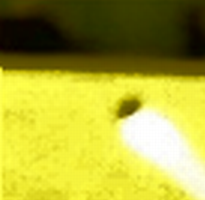 | 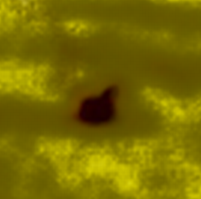 |
| Figure 3. Relative sizes of camera and figure. |
Although the size of the actual camera employed by Andrew Pyrka's colleague is unknown, we can say that present day cameras are usually much less than 12 in. wide. It is unlikely that such a large camera would have been selected for hoisting aloft on a tall pole.
Since the sun was behind the photographer, the light cone might be attributed to specular reflection of sunlight from the highly reflective camera pole. The conical shape of the reflection could possibly arise from a particular geometry relating the sun, the pole, and the camera. Since we know that the angle of incidence of a beam of light equals the angle of reflection, the light would have reflected away from the photographer if the pole had pointed toward or away from him. Therefore, the pole must have extended to the side; that is, in a direction approximately perpendicular to the line joining the photographer and the seated figure. Even then, the observed conical shape could happen only if the sun were in a particular horizontal position in the sky behind the photographer so as to reflect back to the camera. In that position, the angle between the sun and the photographer viewed from the top of the pole would reflect the most light to the camera. Angles from lower points on the pole would reflect less and less light in the direction of the camera. So under these conditions, it may be possible for sunlight reflected from the camera pole to take the shape of a cone.
As can be seen in Figure 3, the maximum width of the light cone is approximately the same as the shoulder width of the seated figure. According to the camera pole interpretation, the more intense light from the sun would have caused blooming of the CCD elements in the camera so as to exaggerate the pole's actual width. Examples of blooming and technical discussions may be seen at
[1],
[2], or
[3].
Although it is possible to argue that the light cone is a reflection of the sun, this conclusion is not consistent with the apparent lack of physical support for a camera pole and the overly large estimated camera size. Therefore, the conventional explanation that the photograph shows a camera on a pole is open to question.
If the objects in the photograph are not Andrew Pyrka's colleague raising a camera on a pole to photograph the formation, what else could they be? Some people have speculated that the figure in the field is consistent with other reports
associating mysterious entities with crop formations. Perhaps some unknown technology is involved that allows the phenomenon to blink into our physical reality to be captured on camera, then disappear just as quickly. Further examination of the image does, indeed, uncover features that have already been associated with unfamiliar UFO technology.
Closer examination of the light cone tells us that this is more than just a reflection of sunlight from a shiny pole. Enhancement of the image in various ways shows that the tip of the cone is bent. See, for example, Figure 2. The bend is seen more clearly when only the blue channel of the image is selected and equalized as in Figure 4. The light energy at the tip of the cone is deflected at a sharp angle before it stops after a short distance without contacting the seated figure.
 |
Figure 4. Equalized blue channel of the image.
|
The left pane of Figure 5 shows the negative of the image, and the middle and right panes show the same image after equalization was applied to improve contrast. Notice that there appears to be a slightly darker egg-shaped pattern in the space around the cone, with the vertex near the seated figure. The pattern is outlined by the graphic overlay in the right pane. The bend in the light cone, emphasized in Figure 4, appears to coincide with the vertex as if it were following the edge of the ovoid shape. Perhaps the outline defines the boundary of a field effect able to deflect the light from the cone. If it also reflected light from the outside, the ovoid shape should appear slightly brighter than the surroundings. This is, in fact, what is observed (i.e., the darker shape in the negative image).
 | 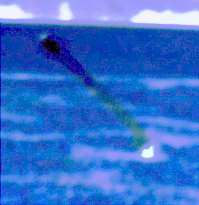 |  |
| Figure 5. Negative of image, enhanced negative image, and overlaid graphic. |
The bent cone of light and the surrounding ovoid shape may be signs of a novel technology in action. Similar effects have been found in photographs of UFOs taken over many years, and a number of cases are documented
here. Typically, a toroidal field effect is found adjacent to the presumed craft, with the craft near or in contact with the ring of the torus. Graphic equalization of the image is usually required to enhance the tori and make them more visible. Figure 6 shows several examples of this effect. Again, the unprocessed image is in the left pane, the equalized image is in the middle pane, and a graphic outlining the torus is superimposed in the right pane.
 |  |  |
 |  | 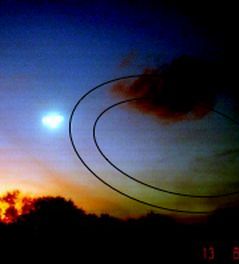 |
 | 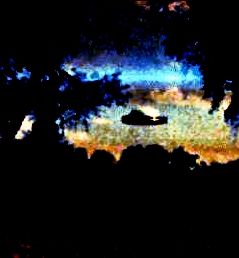 |  |
| Figure 6. Examples of tori accompanying UFOs. |
There is some indication that the torus becomes visible because it is an organizing influence on the particles in the atmosphere. That is, particles may be concentrated inside it, and the ring may become darker or lighter depending on the optical properties of the material and the prevailing lighting conditions. Another possibility is that the boundary or shell of the torus has the property of absorbing light. Light passing through the torus would have a longer path through the shell at an edge. More attenuation would result and the edge would appear darker. Of course, the orientation of the torus relative to the observer would also affect its perceived shape, or whether anything is seen at all.
UFOs have been known to blink into and out of the awareness of an observer, and it is possible that the tori are signs of a technology that allows them to do this. The ovoid in the crop formation might actually have been a toroidal shape seen at an angle. If the ovoid in the photo is like the tori near UFOs, the brief appearance of the cone of light and the figure seated in the field would be consistent with its presence.
As suggested in Figure 4, the presumed ovoid field effect seems to have the ability to deflect the light cone when it contacts the ovoid boundary. Something similar has been seen before in the context of a torus accompanying a UFO. In the Norwood Searchlight Incident of 1949, a searchlight beam deflected by a UFO was simultaneously photographed (see Figure 4 in
this document). That photograph shows the deflection occurring as the beam passes a toroidal shape near the UFO.
Conclusion
With the information at hand, the weight of the evidence does not support the hypothesis that the cone of light and the seated figure are due to the presence of an unnoticed field investigator raising his camera on a pole in order to take aerial photographs of the formation. The light cone might be explained as a reflection of the sun from the pole if certain conditions were met, but the pole does not seem to have the necessary physical support, and the object at the end of the pole seems to be too large for a camera. Instead, the evidence favors the explanation that the figure is an unknown entity that was present only momentarily. The figure was accompanied by the visible signature of a technology that may enable rapid transition between visibility and non-visibility. A similar signature has also been seen in photographs of UFOs that appear to be under intelligent control.























No comments:
Post a Comment